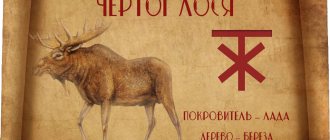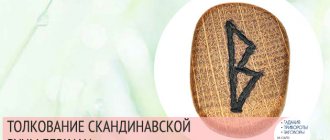The Fox's Hall is the ninth sector of the Svarog Circle. The sacred plant of the palace is currant, the protector goddess is Madder. In Slavic myths, Madder (Mara) was the embodiment of Winter, a symbol of completion and justice. She protects those born in the Fox’s house, and also patronizes magicians.
Everyone whose birthday falls between March 25 and April 17 is under the influence of the Fox totem. What does Fox mean and how to make friends with her? We’ll talk further about who this amulet of the Fox’s palace is suitable for and how to use it.
Meaning and description of the Fox's Hall
According to the legend of the Ancient Slavs, Yarilo-Sun, passing through each Hall, bestows a person with the power of the Sacred Tree of Midgard-Earth.
In the Slavic horoscope, the Hall of the Fox occupies the 10th position of the Svarog Circle. Replaces the Hall of the Wolf and takes over on the Vernal Equinox on April 22 and continues until March 15.
What does the symbol (rune) of the Hall of the Fox look like?
Manifestations of the Slavic worldview, all the knowledge and observations of our ancestors were reflected in the Svarozh Circle.
ATTENTION! Rune (literally – secret, secret, whisper) is an ancient mysterious sign, a magical conductor of encoded information. Rune signs were used BC. e. ancient politicians, philosophers and writers (Julius Caesar, Tacitus, etc.).
The symbol of the Hall of the Fox is a cross with six ends and horizontal straight segments intersecting the vertical main rod-segment at right angles. Externally, the sign is similar to the Support Rune. The Slavs traditionally placed the symbol of the Hall of the Fox in the middle of the sacred star of England.
Patroness of the Hall
Description of the Fox's Hall It is important to start with the patroness in order to better understand the essence and purpose of the magic rune.
The Slavic goddess Mara (by analogy Morena, Moran, Morukha) stands out for its inconsistency and ambiguity from all representatives of the sacred pantheon - the Slavic-Aryan Gods and Goddesses.
FACT. The ancient Slavs worshiped Morena secretly and did not erect temples in her honor. Rituals of worship and placation were carried out during times of disaster, war, plague or other misfortune.
They revered Mara, like other Heavenly Mothers, and pinned their hopes on the Mother of God in the most difficult times. The day of Mary was set on February 15th. On this day they brought her gifts of fruits, delicacies, straw and flowers.
The embodiment of the image of Mara:
- Mother of Snow, Shine, Queen of Winter;
- harsh winter time, night, cold, ice;
- fertility, harvest, harvest;
- fair fate, fair triumph or decision;
- binary image - the physical end of life (death) and the eternal endless path (life) on earth.
THIS IS INTERESTING! Among the Ukrainians, Mara means ghost, haze, ghost; among the Serbs, Mora means master of the house, brownie. In Poland the literal meaning is a nightmare, among the northern Slavs it means a rough spirit, evil spirits.
Russian mythology depicts the Goddess Morena in the form of a tall woman, a beautiful girl in a white robe, or an old woman with a hump.
You may be interested in: Meaning and description of the Hall of the Elk in the ancient Slavic horoscope
Feature - Goddess Morena favors not only those born under the sign of the Fox Hall, but also sorcerers, magicians and secret witches. Moreover, fog, haze, influencing Fate and the further Path appears at noon or midnight (of the day or year).
According to legend, Morena came into the world from the sparks of Svarog. Another origin option is that Mara was born from the ruler of the eternal kingdom of the dead. She appeared to people very rarely. Her ghost servants often walk the Earth at night. And Morena herself can be seen in the rocks, weaving clothes.
In the summer they thanked her and celebrated her. During severe winters they drove away. It was from this ritual that the folk tradition of driving away Maslenitsa emerged. The capricious moraine was fair and saved the harvest from the heat. Sometimes, on the contrary, she became stubborn and sent severe frosts, which killed people, livestock, and vegetation.
The symbol of the goddess Mara, the patroness of the Fox's Hall, is infinity, a water stream in a sleeping or frozen state.
Symbol meaning:
- frozen or persistent energy;
- constrained, hidden stamina, elementality and power, ready to spill out;
- secret destructive force.
sacred plant
The sacred amulet tree for the Hall of the Fox is a bush of white, black and red currants and a hornbeam tree.
Hornbeam
Hornbeam is a symbol of strength, enlightenment, spirituality and purification. Touching his amulet tree, a person replenishes his strength, calms down, and “freezes” in peace of mind.
ATTENTION! Hornbeam lives 300-400 years. Its dense wood does not wear off. Our ancestors made ship screws, wheel axles and spokes, sewing blocks and nails from sustainable hornbeam.
The hornbeam as an amulet for those born during the period of the Hall of the Fox sets one in a positive mood, builds and organizes thoughts and feelings.
Currant
It is believed that currant berries affect general blood flow and normalize blood pressure. Blackcurrant has long been used to reduce blood pressure.
THIS IS INTERESTING! On the night before Ivan Kupala, our ancestors, according to custom, put 1 branch of birch, viburnum, alder, bird cherry and currant into a ritual broom-kupa. This broom was considered healing and magical.
Currants are a symbol of the concentration of the energy of the Sun, creative power, and the highest spiritual elation.
Under the auspices of Marena
The Slavs tell terrible stories about the goddess Marena. It’s as if she is wandering without family and children in the snow, encasing the earth in ice, catching up with cold. She looks at people “for a glimpse” when death has overtaken someone. Mara sums up the life of the deceased and takes him with her, leading him to the afterlife.
Goddess Marena is the patron saint of people from the ninth Svarog circle
The cold, icy goddess was seen as the embodiment of evil spirits . She constantly fights with Zhiv and Yaril, who bring good. Such opposition is the basis of life, its movement, so you should not look at Marena as a negative image.
And the death that Mara brought was not considered by the Slavs as negative. This is only the loss of the bodily shell. The immortal soul of a good person ascends to Light Svarga, and the soul of a bad person dissolves in darkness. The goddess helps the suffering person to leave the body and ascend to heaven. Before this, she gives instructions to the soul of the deceased.
People are grateful to Marena, as she brought:
- winter as a time for fun and relaxation;
- calmness in cold times, when the earth gains new strength;
- change of seasons, another spring with the rebirth of life;
- cleansing of everything old and sick.
By winter, Marena comes from the Far North, where her palaces are located, and in the spring she returns home, giving rise to spring and the new season with its ebullience of life and the awakening of all living things. She sacredly observed the law of life: the young comes to replace the old; healthy - to replace the sick; strong - to replace the decrepit. This is the contradictory image of the goddess of Cold and Renewal.
On a note!
Foxes born under the Hall can turn to Marena with a request. This is a powerful and wise goddess who will come to the aid and support her subject if his strength has dried up or is running out. It will give you energy and renew your life.
Character traits inherent in people of the fox's palace
Each of the 16 Halls bestows upon its owner properties of character, peculiarities of attitude, and perception of life. So, depending on belonging to a certain Hall, the patron God of the Slavic pantheon, a person from birth is endowed with special inclinations, talents and Fate.
What is destined for the people of the Fox's Hall:
- The fate is not easy, the path is thorny but varied;
- seekers by nature, looking for the essence and meaning in everything;
- love experiments, are curious and inquisitive from childhood;
- there is no fear of the future, they strive to comprehend the unknown;
- are constantly in search of choice;
- practicality, on the other hand - scattered interests - pendulum people;
- live by the motto: “Trust, but verify”;
- they love to “profit” from the fruits of other people’s labor;
- often need a patron, a mentor;
- strive throughout their lives to find spiritual and physical harmony;
- They value a state of calm and tranquility like no one else.
You will be interested in: Hall of Tura: Meaning and description, character traits inherent in men and women
Characteristic features:
- natural cunning;
- innate charm;
- the ability to say something nice to your interlocutor, flattery and servility;
- resourceful mind;
- quick change of mood - from delight to disappointment.
Features for men
The men of the Hall of the Fox are distinguished by:
- restraint, even emotional coldness;
- determination to achieve set goals;
- iron will on the path to success.
Minuses:
- reflection, like to “cut sawdust”;
- they think and weigh a lot before taking decisive action;
- cannot stand monotony (in love, work);
- routine quickly drags on and kills the desire to act.
Fox men are excellent creative managers and leaders by nature.
Features for women
Virtues of women of the Hall of the Fox:
- the desire for family and continuity of generations - they value parents, protect, care for, consider them a stronghold of Wisdom and Origin;
- loyalty to friends, one's word;
- devotion and perseverance in marital relationships;
- children are raised in the spirit of unshakable family traditions.
Characteristics of female “Foxes”:
- also do not tolerate monotony and monotony;
- strive for self-realization in the professional field, choose dynamic activities;
- are well versed in the flow of information;
- somewhat selfish and demanding;
- life credo: “I want everything, more, and faster”;
- they perceive delays painfully, intermediate results are of little satisfaction;
- strive for a successful completion of the matter, no matter what the cost (impatience by nature).
Totemism among Native Americans
The first to use the term “totem” was traveler J. Long in 1791, borrowing it from the vocabulary of the Ojibwa tribe. Thus, the Indians called a kind of coat of arms of the clan, its face and protector. Members of the tribe believed that the animal they worshiped could protect them from harm and endow them with its abilities. It was believed that a warrior who chose the path of a hawk or jaguar becomes faster. The leaders preferred more intelligent representatives of the natural world, for example, the raven or the eagle owl. At the same time, the totem of, for example, a fox could be both tribal and personal. As a sign of belonging to a particular caste, the devotee carried with him a part of an animal, fur or a feather. To obtain skin or claws in battle was considered a courageous act, and therefore worthy of respect. However, the Indians lived in harmony with the wild and never took more than they needed to thrive or survive.
The meaning of the Fox Hall amulet
The Fox Hall amulet provides special support to people born under this sign. Strengthens the natural connection with the patron goddess Morena.
A powerful talisman guarantees:
- support from higher powers;
- attracting good luck;
- activation of vital energy;
- strengthening self-confidence;
- protection from diseases, the “evil eye”, damage, black envy from the outside.
The Fox's Hall amulet will help in resolving controversial issues. In a situation of difficult turning points, he will suggest the right way out.
The main purpose is a push, a start to spiritual development and self-improvement.
Patron deity
Those who came to this world under the sign of the Fox found protection from the goddess Madder. Leaving her northern kingdom, she brings winter to the world of people. Under her attentive gaze, nature peacefully falls asleep until spring comes.
Being the mother of Ra, she carries out an important mission in our world - she is a conductor of human souls. Guiding towards peace and eternity, she will touch every soul and, having learned about her actions during earthly life, will give appropriate instructions. She endowed the people of this palace with her wisdom.
The meaning of a tattoo with the symbol of the Hall of the Fox
CAREFULLY! The tattoo consolidates the magical power of the Fox Hall talisman.
Excessive resourcefulness, assertiveness and cunning threaten unpleasant metamorphoses. Endless subtle calculations will quickly turn a person into a manipulator and intriguer. You can lose trusting relationships with loved ones.
White magicians recommend wearing a talisman in the form of a pendant, ring or pendant. Such a “removable” amulet will allow you to control the powerful influence of the unpredictable Goddess Mara.
Who needs to wear a talisman
The trickster fox, according to the ancient Slavs, personified the speed of thought, ingenuity and cunning.
Magic symbols endow the owner of the talisman with:
- resourcefulness;
- resourceful mind;
- the ability not only to reveal one’s talents, but also to use natural talent;
- insight - to see “two arshins into the ground” (foresee the future)
- the ability to correctly calculate and plan further actions;
- the gift of redistributing energy into a positive beginning.
You may be interested in: Hall of the Swan: Description and meaning
For someone who lacks these qualities, lacks a natural “smell” of intuition, the talisman-amulet will become an assistant and guide in understanding the world and, above all, oneself.
For someone who often makes mistakes in people and does not know how to foresee and calculate possible mistakes and their consequences, the symbol of the Fox's Hall will become a rational grain, as well as a stimulator of the gift of foresight and concentration of internal energy.
LiveInternetLiveInternet
S_a_n_y_a
all posts by the author
In many folk traditions, the fox (“Reineke”) is an animal that personifies insidious cunning and treachery. Its reddish fur resembles fire, which made it possible to rank it, along with the lynx and the squirrel, among the retinue of the devil: see the expression “wild damn fox.” In ancient Rome, the fox was considered the demon of fire. At the festival of the goddess Ceres, in order to protect crops from fire, a lit torch was tied to the fox’s tail and chased through the fields. As a remedy against witchcraft, a starfish sprinkled with the blood of a fox was nailed to the door.
Foxes were considered (as in Ancient China) to be especially lustful animals, so crushed fox testicles were added to wine as a sure remedy as a love potion, and a fox tail was worn on the hand, which was supposed to have a stimulating sexual effect.
Among the Germans, the fox was a symbolic animal of the god Loki, rich in inventions (this role of the “trickster” was played by the coyote among the North American Indians).
The fox played an important role as a symbol of eroticism and the art of seduction in East Asia; In ancient China, the prevailing idea was that foxes (huli) could live up to a thousand years, and then they would grow a new tail, which had a special ability for sensual seduction. Ghosts rode foxes; female foxes never changed their clothes, but they always remained clean. They are incredibly seductive and can, through unbridled erotic claims, deprive the men they come across of their vitality.
in Chinese traditional mythology n. Huli-jing (literally “fox-spirit”, in modern colloquial language also “temptress”) is a werewolf fox, a good or evil spirit. Related to Japanese kitsune, Korean kumiho and European fairies.
Traditionally, the Chinese believed that all beings could take on human form, acquire magical properties and immortality, provided they found a source of such energy, such as human breath or an elixir from the moon or sun.
Descriptions of were-foxes are often found in medieval Chinese literature. Huli-jing are most often represented as young, beautiful girls. One of the most infamous were-foxes was Da Ji (妲己), the semi-legendary concubine of the last emperor of the Shang Dynasty. According to legend, the beautiful daughter of a general, she was married against her will to the tyrant ruler Zhou Xin (紂辛 Zhòu Xīn). The maid of the goddess Nuwa, a nine-tailed werewolf fox, who was once offended by him, entered Da Ji’s body in revenge, expelling the real soul of the concubine from there. Under the guise of Da Ji, the were-fox and the cruel ruler came up with and carried out many cruel and cunning tricks and tortures for their subordinates, for example, forcing them to hug white-hot iron rods. Because of such an unbearable life, the emperor's subjects rebelled, as a result of which the Shang dynasty ended and the era of the reign of the Zhou emperors began. Later, Emperor Wen's semi-legendary prime minister Jiang Ziya exorcized the fox spirit from Da Ji's body, and the goddess Nuwa punished the nine-tailed fox for excessive cruelty.
It was usually believed that a meeting with a huli jing, as a bad omen, did not bode well for a person. However, in the popular short stories of the 17th century Chinese writer Pu Songling[1], there are also quite harmless stories about love between a fox girl and a handsome young man. Transforming into beautiful, young and sexy girls, werewolf foxes skillfully seduce men (the bright beginning of Yang), for the sake of energy (qi), blood or semen to improve their magical capabilities. As a result, a person’s vital energy is weakened and he often dies from exhaustion. The fox thus reaches the highest stage of development and becomes an immortal fox (狐仙). Hence the modern Chinese use of the word “huli jing” to mean “vampire woman,” a “cunning seductress” who seduces married men for money and entertainment. It was believed that a werefox, even in human form, could be recognized by its non-disappearing tail. (Chinese proverb: Chinese 狐貍精露尾 “the tail gives away a werefox” means that deceit and cunning can always be noticed by certain signs.)
Huli-jing is credited with extraordinary beauty, mental acuity, cunning, cunning, dexterity and elusiveness. In their original form, they look like ordinary foxes. The main indicator of the power of a werewolf's witchcraft is its age. Having lived 50 years, a fox can turn into a woman; after 100 years, she is also able to transform into a man and learn about what is happening a thousand miles away from her. This second type, with a wide range of transformations, is most often found in Chinese beliefs.[2] After 1000 years of life, the laws of Heaven are revealed to the fox and it becomes the Heavenly Fox. Huli-jing live in caves and love the cold. They love chicken. They can change coat color, although the usual color is bright red. They have special charms; when their tail touches the ground, a flame can flare up. With age they acquire the gift of foresight. They often live in a flock. They are found around or in cemeteries themselves. It was believed that the souls of the dead could connect with the body of the Huli Jing and thus communicate with the world of the living. With their intrigues and jokes they cause a lot of trouble to mortals, and sometimes kill people. Sometimes Huli Jing can also help and support a person, which, however, corresponds to their unpredictable and changeable nature.
For the peoples of the Far East, the fox is a representative of evil spirits. For example, in Chinese mythology, a fox with a lifespan of 800 to 1,000 years is considered a bad omen. It is enough for him to hit the ground with his tail for a fire to break out. He is able to foresee the future and can take on any form, preferring old men, young women and scientists. He is cunning, cautious and distrustful, and his main pleasure is to fool and torment people. The souls of the dead sometimes move into the body of a fox, which lives near the graves.
The Sacred Book of the Werewolf by Victor Pelevin tells the love story of an ancient werefox named A Huli and a young werewolf.
In 2008, the Chinese film Dyed Skin (畫皮 pinyin: huà pí), directed by Gordon Chen, was released. The script is based on one of Pu Songling's short stories, where the main character, a werewolf fox, devours men's hearts to maintain her beauty and youth. However, this is more of a melodrama than a horror film.
In Ancient Japan, a fox spirit that can transform into a human is called Koki-Teno (similar to the German concept of "Wehr-Fuchs" - German Fucks, fuchs - fox). Foxes, thanks to their art, can lead a person blinded by feelings into insanity and destroy; in Japanese legends they play the role of a witch (who can take on another form). It was proposed to burn foxes and scatter their ashes in water.
Yet the fox plays not only a negative role.
The white fox is the supreme animal of the rice god Inari, and in the Tori shrine, next to this god there are often wooden or stone figurines of foxes, which hold in their mouths a sacred scroll or the key to heaven. The tip of a fox's tail is often a symbol of the "gem of happiness."
Shooting stars are called "sky foxes."
In “falling” stars and “tailed” comets they saw space or celestial foxes descending to earth.
According to Chinese beliefs, a fifty-year-old fox turns into a woman, a five-hundred-year-old becomes a seductive girl, and a thousand-year-old takes on the body of a heavenly fox who knows all the secrets of nature. Basically, the negative symbolic meaning of the fox still prevails. Dürer's painting Mary with Many Animals shows a fox tied up, apparently as a reminder of her connection with the devil.
By chance, a fox may still be an attribute of a saint, such as St. Boniface and St. Eugene, although in biblical usage she personifies treachery and anger. The old saying about the fox who preaches to the geese means insidious greed;
in Upper Austria "fox" had the same meaning as "devil" ("devil's fox"), and in Upper Schleswig during an approaching thunderstorm they said, "it is the fox who is boiling something." In Grielshausen's Simply Cissimus, "fox's tail" meant "to flatter hypocritically."
The negative assessment of “Master Reinecke” in medieval bestiaries made this name a stable combination, meaning that a person is like a deceitful and treacherous animal. “If a fox is hungry and cannot find anything to eat, it will rummage through the reddish soil so that it looks as if it is stained with blood, and then fall to the ground and hold its breath. The birds see her lying lifeless with her tongue hanging out and assume she is dead. The birds land on it, and the fox grabs them and eats them. The devil does the same: he appears alive as dead until he grabs them in his mouth and swallows them” (Unterkircher).
“A fox on a coat of arms or on a coat of arms usually has the meaning of a treacherous mind, and they are usually worn by those who follow their coat of arms in their actions.”
Among the Indians of North America, the Greenlandic Eskimos, the Koryaks, the peoples of Siberia, and in China, there is a well-known story about a poor man, to whom L. comes to his house every morning, sheds his skin and becomes a woman; when a man accidentally discovers this, he hides the skin and the woman becomes his wife; but the wife finds her skin, turns around L. and runs away from the house.
In folk tradition, a special day was celebrated associated with L. or with the beginning of hunting for it, for example. Martyn-Lisogon Day (April 14)
The fox serves as an alchemical symbol for the temporarily solidified red sulfur, symbolizing the earthy nature, in contrast to the airy nature of the rooster.
The Teumes fox is an animal that cannot be overtaken in ancient Greek mythology.
A monstrous fox that attacked the inhabitants of Boeotia. She grew up to the destruction of the Thebans through the wrath of Dionysus [1]. It was predetermined by fate that no one could overtake her. Every month the Thebans gave one of the young men to the fox to be eaten. At the request of Amphitryon, Cephalus released a dog against the fox, from which no one could escape. Zeus turned them both to stone
More famous foxes
Renard (Reinecke the fox) is a character in European folklore. Lisa Patrikeevna is a character in Russian folklore. Far Eastern werewolves: Kitsune (Japan) Kumiho (Korea) Huli-ching (China)
Fox and Cat from the fairy tale “Pinocchio” Fox Alice (“Pinocchio”) Brother Fox (“Tales of Uncle Remus”)
Aesop's Fables: The Fox and the Cheese The Fox and the Grapes The Fox is the faithful friend of the Little Prince in the fairy tale of the same name by Antoine de Saint-Exupery Fox Nikita from the fairy tale “Nikita the Fox” by Ivan Franko Ludwig the Fourteenth is a little fox from Jan Ekholm’s book “Tutta Karlsson the First and Only, Ludwig the Fourteenth” and etc." Fantastic Mr. Fox from the book of the same name by Roald Dahl Sylvia - a woman who turned into a fox (David Garnett's novel "The Fox Woman") Silva - a fox who turned into a woman (Vercors' novel "Silva") A Huli ("The Sacred Book of the Werewolf", Pelevin) Chiefa is a fictional fox mentioned in Max Fry's books. Red Foxy is a fictional creature close to foxes (from the stories of Vitaly Trofimov-Trofimov “The Green Sun” and “The Logic of Subversion”) Domino is a black-brown fox from the story of the same name by E. Seton-Thompson.
Abu Al-Hossein - the fox from the Arabian tales of 1001 nights
Quickie and Goldmane, characters from the opera “The Adventures of the Trickster Fox,” Leos Janacek Basil Brush is a glove doll, host of a British TV show.
Rita, cartoons "Jack of the Jungle", "Tricky Jack" - city fox, partner of the main character. Todd, The Fox and the Hound, D. P. Mannix (Disney animated film adaptation). Robin Hood - in the Disney cartoon "Robin Hood" The Nine-Tailed Demon Fox belongs to Naruto Uzumaki (manga "Naruto") Kuugen Tenko (Japanese 天狐空幻, Tenko Kūgen) from the work "Inari in Our House" (Japanese 我が家のお稲荷さま。, Wagaya no Oinari-sama). The author of the novels is Jin Shibamura, the illustrator is Eizo Hooden. Manga adaptation - Suiren Shofuu. Anime - released by Prower - from the Sonic the Hedgehog series Fox Fiona - comic book character "Sonic the Hedgehog" Fox Nikita (animated series) based on the fairy tale of the same name by Ivan Franko Vuk and other characters from the cartoon "Vuk" (based on the stories of I. Fekete) Ozy and Millie Slylock Fox Fox McCloud, Crystal from the Star Fox video game series Five-tailed fox Yubi (in Latin transcription Yobi) from the Korean cartoon “Fox Girl” Pokemon Vulpix and Ninetales
(https://slovari.yandex.ru, .symbolsbook.ru, wikipedia)
Rules for cleaning and activating the amulet
It is preferable to purchase the protective amulet of the Hall of the Fox from silver or gold. It is worn around the neck, and the chain is chosen from the same metal as the talisman itself.
Before putting on an amulet, it is important to “launch” the magical power, cleanse it and charge it with your energy.
ATTENTION! The ritual is performed in complete solitude, in a relaxed, calm state, with bright thoughts and feelings.
The setup and activation procedure is simple:
- concentrate thoughts on the meaning and power of the amulet, discard everything unnecessary and otherworldly;
- put the talisman in your palm, squeeze it, press it to your chest;
- mentally or in a whisper, accurately formulate desires, goals, dreams (without using the negative particle He), ask for protection and help from higher powers;
- visualize your dreams as real events in life;
- do not doubt and sincerely believe in the power of the amulet;
- at the end, thank your talisman, make a promise to faithfully keep and take care of it.
IMPORTANT! For at least 5-7 days after activation, do not part with the amulet, do not remove it at night (do not lose contact).











